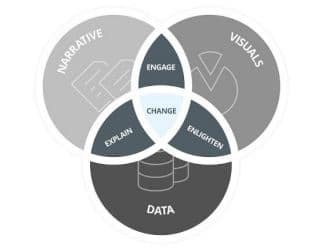Teachers and Examiners (CBSESkillEduction) collaborated to create the Storytelling Through Data Class 12. All the important Information are taken from the NCERT Textbook Artificial Intelligence (417).
Storytelling Through Data Class 12

Why storytelling is so powerful and cross-cultural, and what this means for data storytelling?
Stories give the audience engrossing experiences that take them to different places and eras. They create a sense of identity and group belonging. For these reasons, storytelling is regarded as a potent factor that strengthens global networking by promoting cross-cultural understanding and raising awareness of cultural differences. The skill of storytelling is essential to indigenous civilizations.
The steps involved in telling an effective data story are given below:
- Understanding the audience
- Choosing the right data and visualisations
- Drawing attention to key information
- Developing a narrative
- Engaging your audience
Storytelling Through Data Class 12
Storytelling with Data
Data, graphics, and narrative are the three main components of data storytelling, an organised method for conveying insights gleaned from data. When the story is supported by data, it helps the audience understand what is going on in the data and why a certain insight has been produced. When applied to data, graphics can reveal insights to the audience that they might not have noticed without the charts or graphs.
Last but not least, when narrative and images are combined, an audience can be entertained. A data story that can impact and motivate change is created when the appropriate graphics and narrative are combined with the appropriate facts.

By the numbers: How to tell a great story with your data?
If the data is presented in a succession of fragmented charts and graphs, the audience may find it difficult to interpret it or, worse yet, draw the incorrect conclusions. As a result, a narrative is significant because it clarifies what is happening in the data set. It provides relevance and clarity, as well as context and meaning. A story keeps the audience interested while directing their attention to important details that should not be missed.
Good stories must first be derived from data relationships rather than just from the data itself. A closer examination reveals the connections between the various data points. The following are some simple steps that can help you identify interesting tales in the data sets:
Step 1: Get the data and organise it.
Step 2: Visualize the data.
Step 3: Examine data relationships.
Step 4: Create a simple narrative embedded with conflict
Data storytelling has acquired a place of importance because –
a. It is an effective tool to transmit human experience. Narrative is the way we simplify and make sense of a complex world. It supplies context, insight, interpretation—all the things that make data meaningful, more relevant and interesting.
b. No matter how impressive an analysis, or how high-quality the data, it is not going to compel change unless the people involved understand what is explained through a story.
c. Stories that incorporate data and analytics are more convincing than those based entirely on anecdotes or personal experience.
d. It helps to standardize communications and spread results.
e. It makes information memorable and easier to retain in the long run.
Employability Skills Class 12 Notes
- Unit 1 : Communication Skills – IV
- Unit 2 : Self-Management Skills – IV
- Unit 3 : Information and Communication Technology Skills – IV
- Unit 4 : Entrepreneurial Skills – IV
- Unit 5 : Green Skills – IV
Employability Skills Class 12 MCQ
- Unit 1 : Communication Skills – IV
- Unit 2 : Self-Management Skills – IV
- Unit 3 : Information and Communication Technology Skills – IV
- Unit 4 : Entrepreneurial Skills – IV
- Unit 5 : Green Skills – IV
Employability Skills Class 12 Questions and Answers
- Unit 1 : Communication Skills – IV
- Unit 2 : Self-Management Skills – IV
- Unit 3 : Information and Communication Technology Skills – IV
- Unit 4 : Entrepreneurial Skills – IV
- Unit 5 : Green Skills – IV
Artificial Intelligence Class 12 Notes
- Unit 1: Capstone Project
- Unit 2: Model Lifecycle
- Unit 3: Storytelling Through Data
Artificial Intelligence Project
